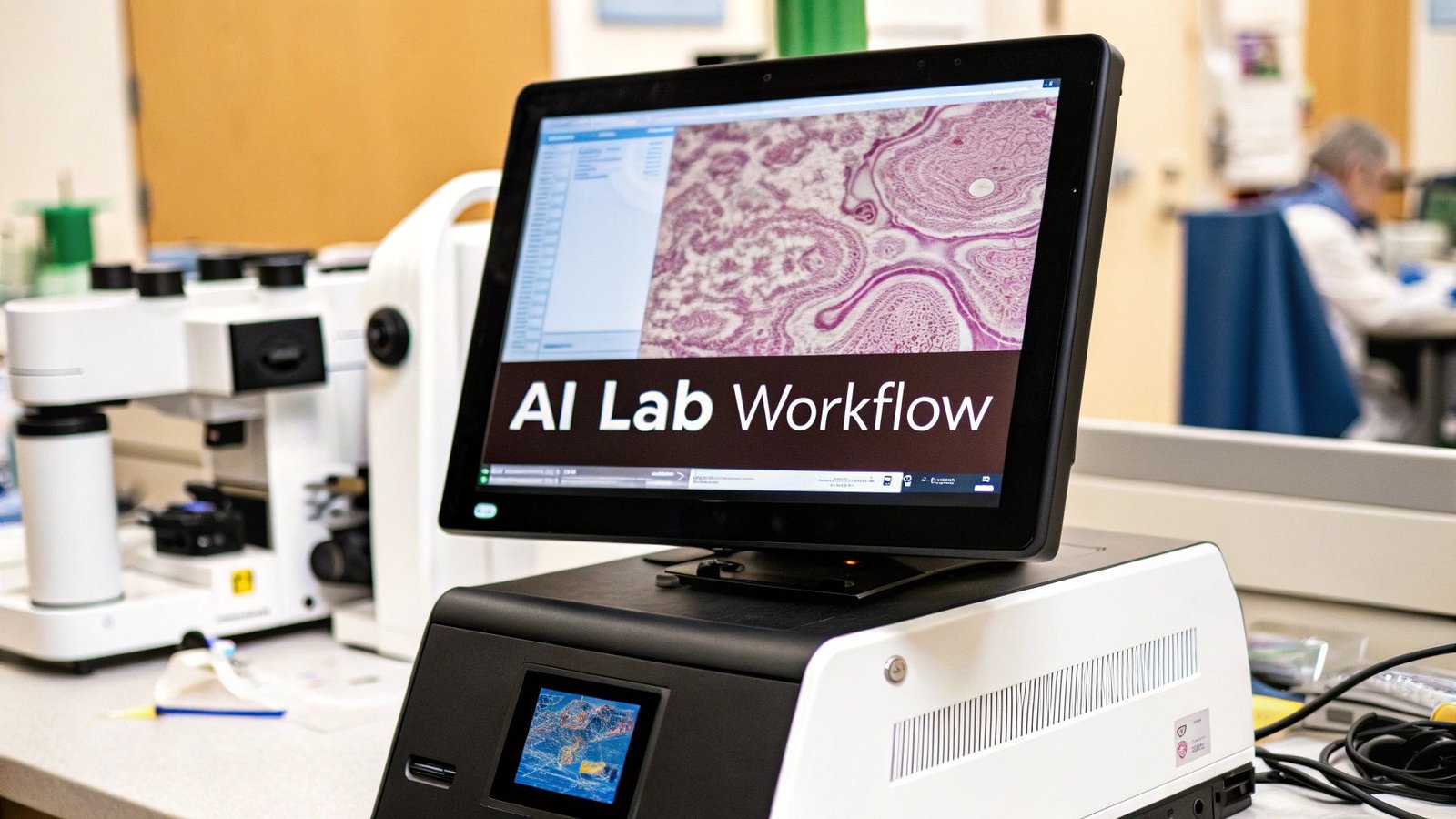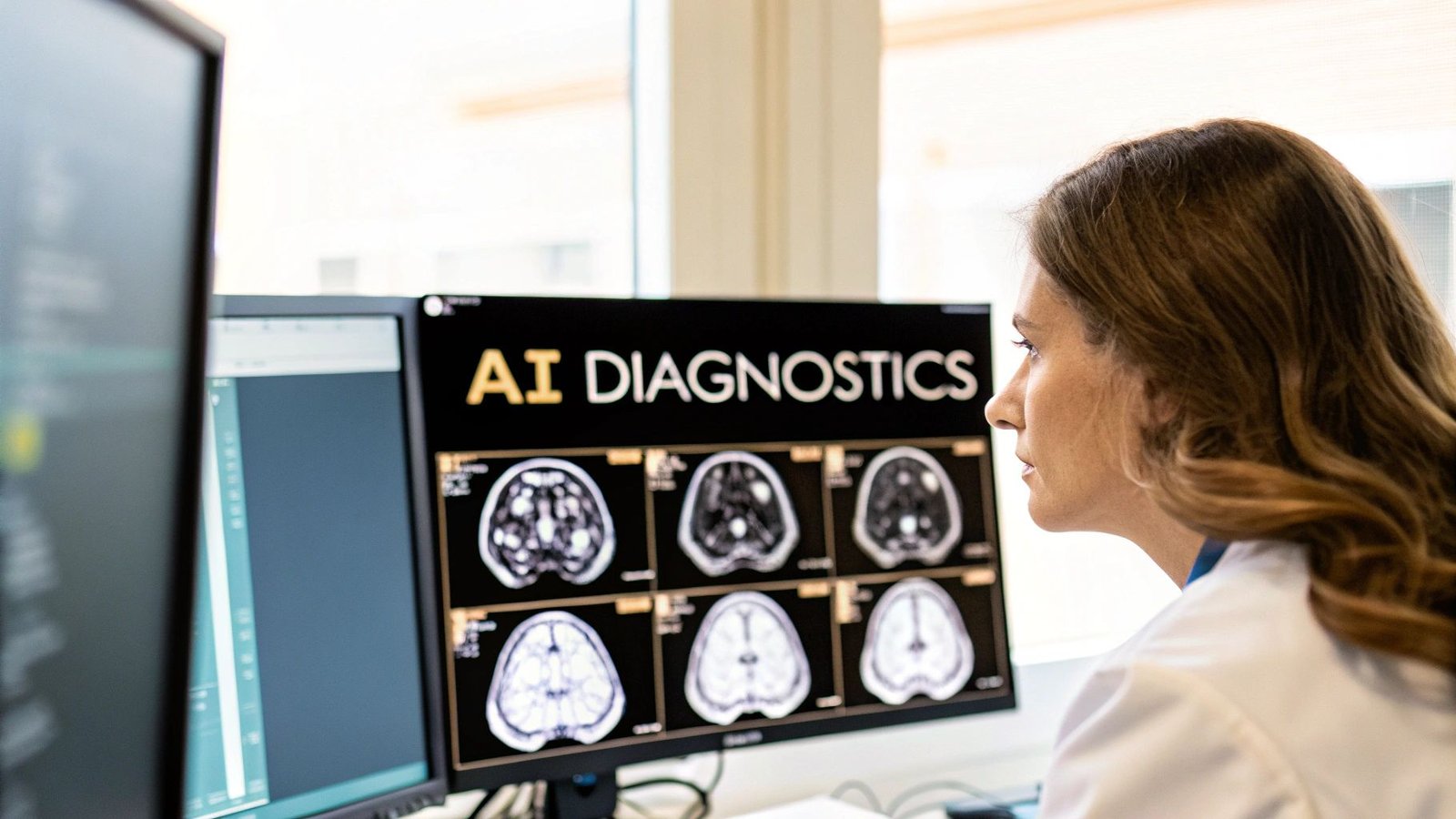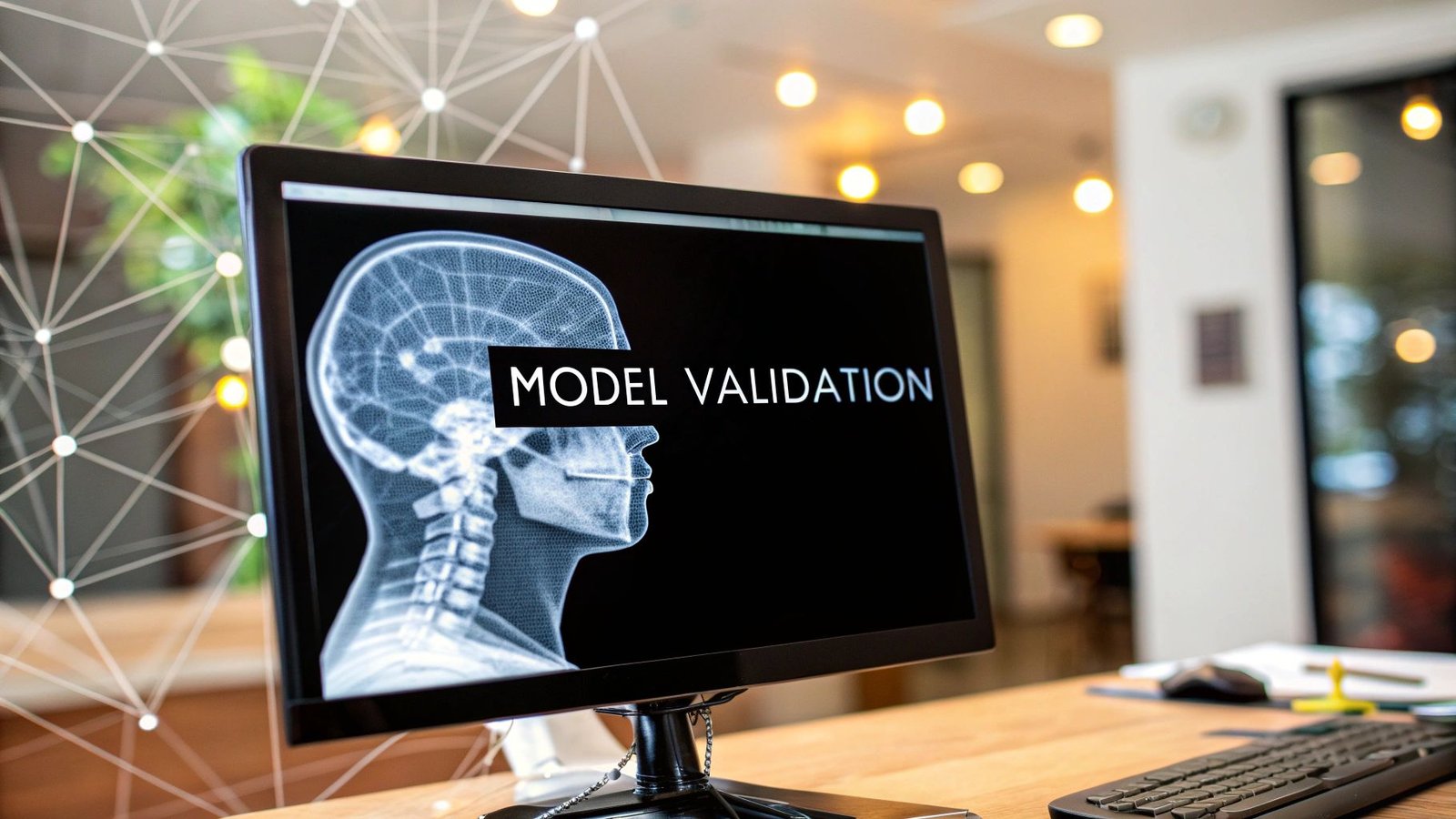Imagine a world where a patient in a small town can get a diagnosis from a world-renowned pathologist thousands of miles away, almost instantly. That world is here, and it’s powered by digital pathology software. This isn't just about swapping glass slides for pixels; it's about fundamentally changing how we see, understand, and combat disease.
The Digital Revolution in the Pathology Lab
For over a century, the microscope has been the pathologist's most iconic tool. But as powerful as it is, it has always had one major limitation: it ties a diagnosis to a physical slide in a specific place. Need a second opinion? That fragile piece of glass has to be packed, shipped, and prayed for, all while a patient anxiously waits.
Digital pathology software completely shatters those chains. It takes a tissue sample and converts it into a high-resolution digital image—a dynamic, shareable asset. Suddenly, that single slide can be viewed by experts anywhere in the world, securely and in real-time.
Think of it like this: the old way was a paper map—a static, one-person view. The new way is a live, interactive GPS that offers layers of data, collaborative input, and a much clearer path to the destination.
Empowering Pathologists and Patients
This is a game-changer for pathologists. They're no longer hunched over a microscope, limited by what the lens can show. Now, they have powerful software tools to zoom, annotate, and analyze tissue with incredible precision, all from their computer screen. It’s an environment built for collaboration, where a team of specialists can huddle around a complex case digitally, as if they were all in the same room.
The impact is immediate and profound:
- Global Collaboration: Second opinions that once took days or weeks now take minutes. This completely reshapes the timeline for a diagnosis.
- Enhanced Precision: Sophisticated viewing tools let pathologists catch subtle clues that might be missed on a traditional slide.
- Smarter Workflows: Labs can finally manage their caseloads more effectively, automating tedious tasks and focusing their energy where it matters most.
We're building a smarter, more connected diagnostic ecosystem. When patient data and pathology images are centralized, labs create an incredible knowledge base that not only helps diagnose the case at hand but also drives research that will improve outcomes for countless patients in the future.
Building the Future of Diagnostics
The engine behind this revolution is powerful, intuitive software. Here at PYCAD, we know that a generic, off-the-shelf solution just won't cut it for the complex needs of today's pathology labs. That’s why we at PYCAD, build custom web DICOM viewers and integrate them into medical imaging web platforms, creating a seamless system that feels like a natural extension of a lab's workflow.
By tailoring the software, we help labs unlock the true power of their digital images. The technology should serve the expert, not the other way around. To see how we've helped other organizations make this leap, feel free to explore our work on our portfolio page.
At the end of the day, this whole movement is about one thing: getting faster, more accurate answers to the people who are waiting for them.
From Glass Slide to Digital Insight
The journey from a physical tissue sample to a dynamic, data-rich image is a fascinating one. It all starts in the lab, not with a computer, but with a simple glass slide. This slide holds the biological story, but its full potential is only unlocked when it enters the digital world through a whole-slide scanner.
Imagine this scanner as a super-powered digital microscope. It meticulously moves across the entire tissue sample, capturing thousands of incredibly detailed, high-resolution snapshots. Specialized software then flawlessly stitches these individual frames together, creating one massive, cohesive file: the whole-slide image (WSI). This isn't just a static picture; it's a fully explorable digital replica of the slide, often packed with gigabytes of information.
This infographic beautifully captures the essence of this leap—from the physical confines of a microscope to the expansive digital canvas on a monitor.
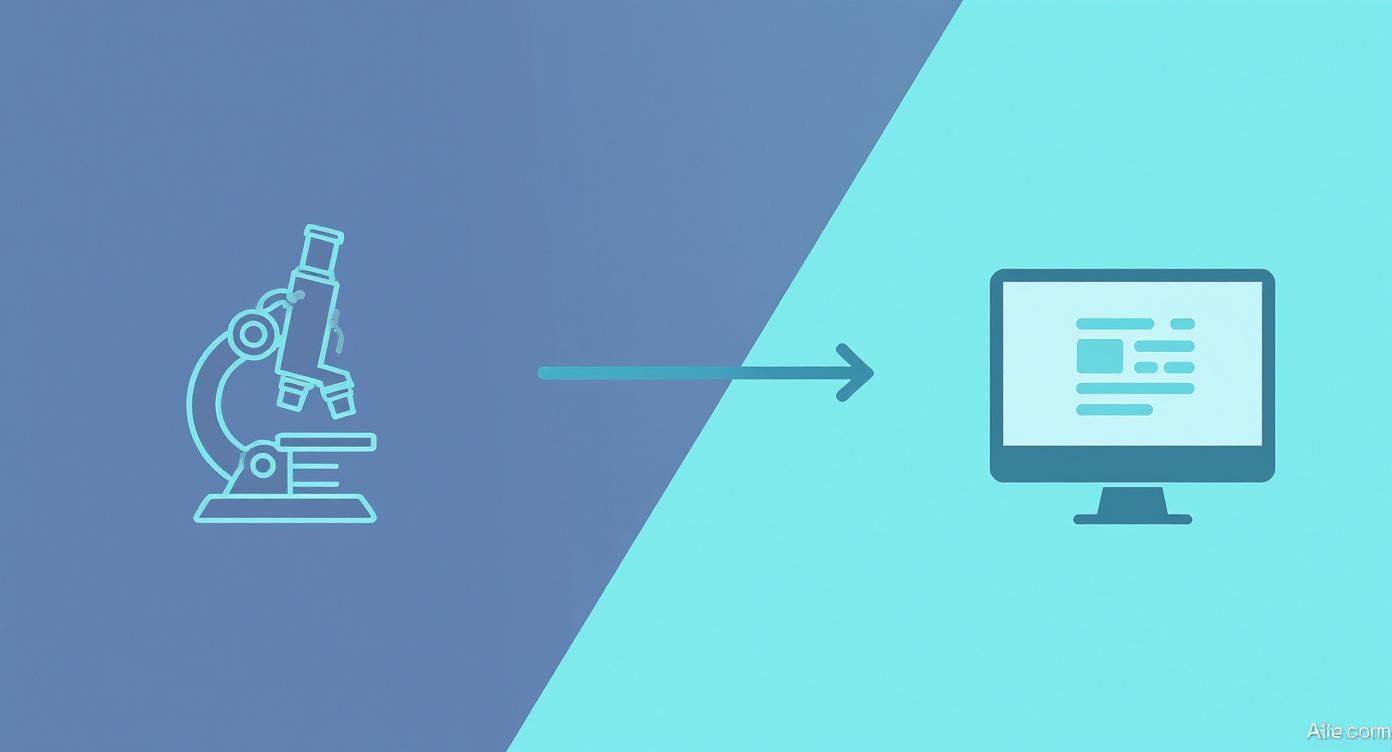
It’s a powerful visual that speaks to the core evolution of the pathologist's workflow, trading physical limitations for digital freedom.
Creating a Universal Language for Images
So, you have this incredible digital slide. How do you make sure it can be opened, viewed, and analyzed reliably on any system, anywhere? This is where a shared language becomes essential. In medical imaging, that language is DICOM (Digital Imaging and Communications in Medicine).
Think of DICOM as the universal translator for medical images. It ensures that an image created by one company’s scanner can be perfectly understood by another company’s software. This standardization is the foundation of a connected, collaborative lab environment. It breaks down technical barriers and guarantees that pathologists see a consistent, high-fidelity image no matter what tool they’re using.
At PYCAD, this is at the heart of what we do. We at PYCAD, build custom web DICOM viewers and integrate them into medical imaging web platforms. Our goal is to ensure this universal language is spoken fluently throughout the entire diagnostic journey. You can explore examples of our integration work on our portfolio page.
The Digital Microscope and Its Command Center
With the WSI standardized and ready, the pathologist opens it in the digital pathology software. This is their new microscope, and it comes with superpowers. With a click and a scroll, they can:
- Pan effortlessly across the entire tissue landscape.
- Zoom in an instant from a bird's-eye view down to the finest cellular details.
- Annotate directly on the image, marking areas of interest, taking precise measurements, and sharing notes with colleagues in real-time.
But where do these massive files live? They are housed in an Image Management System (IMS).
The IMS is the command center for the digital lab. It's a secure, searchable, and highly organized library for every single digital slide—the single source of truth for the entire diagnostic imaging operation.
This system is much more than a simple digital filing cabinet. It intelligently links images to patient data, tracks case workflows, and manages user access to maintain security and compliance. By connecting the scanners, viewing software, and the laboratory's information system, the IMS becomes the operational backbone that makes the whole process work. It transforms a collection of individual files into a powerful, collective knowledge base ready for diagnosis, research, and discovery.
What Makes Modern Pathology Platforms So Powerful?
What’s the real difference between a basic image viewer and a true diagnostic command center? It’s all about a collection of smart, interconnected features designed to amplify a pathologist’s own expertise. Modern digital pathology software is so much more than just putting a slide on a screen; it’s about creating an interactive environment for diagnosis.
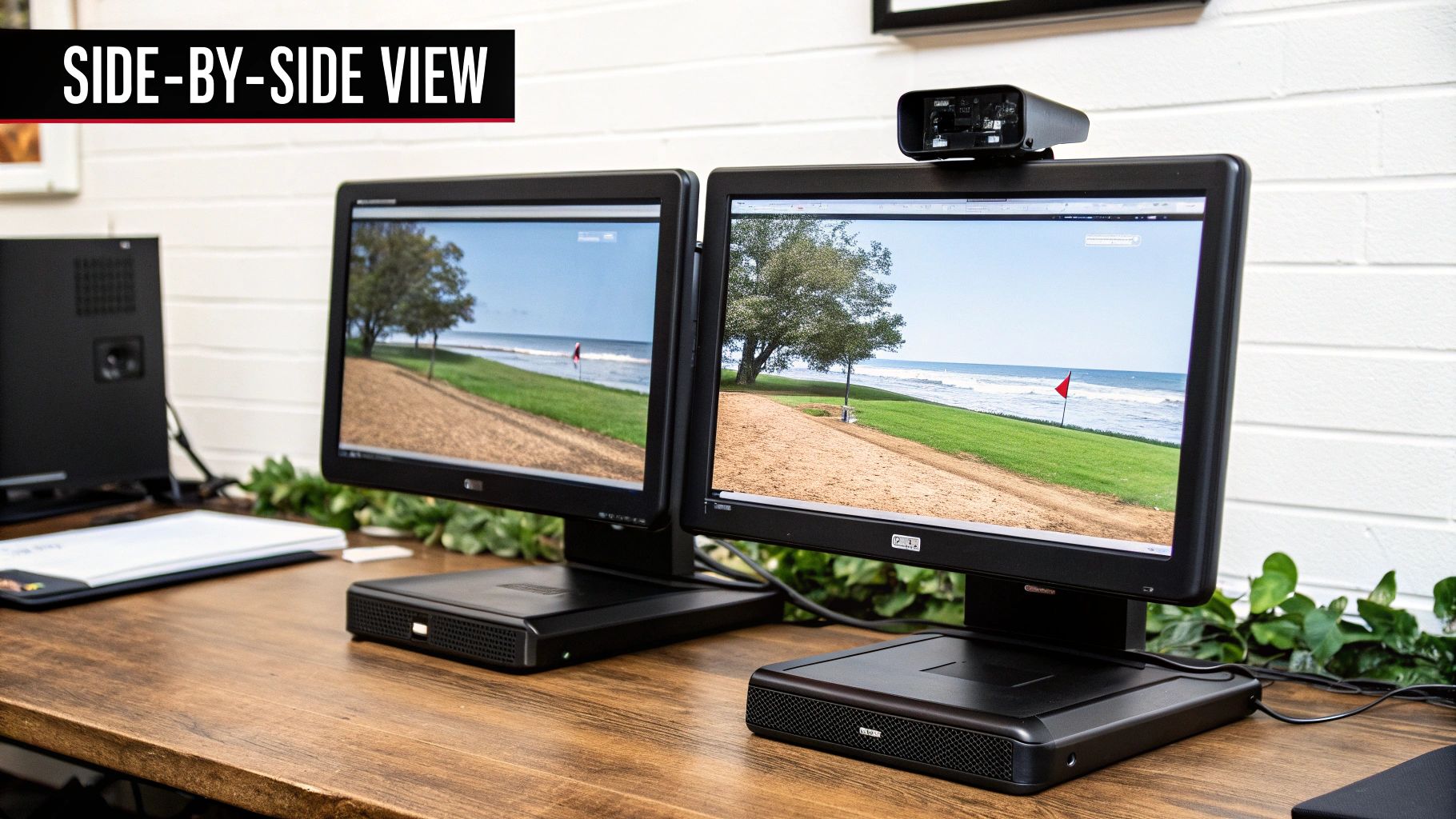
Think of this environment as a digital workbench. It's where raw image data gets turned into clear diagnostic insight, all backed by tools that make even the most complex analysis feel natural and efficient. The whole point is to give pathologists everything they need to make confident, swift decisions.
Advanced Viewing and Comparison Tools
Viewing capabilities are the heart of any digital pathology platform, but the best systems go far beyond simple zoom and pan. They offer tools that open the door to a much deeper level of investigation, helping pathologists spot connections and patterns they might have otherwise missed.
Here’s what that looks like in practice:
- Side-by-Side Slide Comparison: Remember trying to compare two glass slides under a microscope? You’d have to constantly swap them out, relying on memory. Digital software lets you pull up multiple whole-slide images right next to each other—perfect for directly comparing a biopsy with a later resection.
- Synchronized Multi-Viewer Windows: This takes comparison to another level. A pathologist can link two or more image windows so that when they pan or zoom on one, the others follow in perfect sync. This is a game-changer for comparing different stains, like H&E and IHC, on tissue from the same block.
- Intuitive Annotation Toolsets: These are the digital equivalent of a pathologist's pen, but with superpowers. You can draw precise boundaries around a region of interest, measure a tumor with sub-micron accuracy, and drop detailed notes right onto the image for your colleagues to see.
Seamless Laboratory Information System Integration
If there’s one feature that truly defines workflow efficiency, it’s how well the software integrates with the Laboratory Information System (LIS). The LIS is the lab's central hub, handling everything from patient demographics to case data and final reports. When digital pathology software is stuck in its own bubble, it creates bottlenecks and frustration.
A properly integrated system pulls everything into one unified workspace. When a pathologist opens a case, they don’t just see the digital slide—they see the entire patient history and all relevant data, pulled directly from the LIS. No more switching between different programs, which saves an incredible amount of time and cuts down on the risk of typos or errors.
This connectivity turns the platform into a single source of truth. By breaking down data silos, labs create a fluid workflow where diagnostic images and patient context coexist, leading to a more complete and accurate diagnostic picture.
At its heart, a modern digital pathology platform operates like a highly specialized knowledge hub, organizing massive amounts of diagnostic information. In many ways, these platforms share principles with sophisticated knowledge base management systems by making complex data easy to find, share, and analyze.
Collaboration and Customization
Modern medicine is a team sport, and diagnostics are no exception. That’s why collaborative features are non-negotiable. The software must allow pathologists to securely share slides in real-time for quick consultations or formal tumor boards. This means multiple people can view and annotate the exact same image at the same time, no matter where they are in the world.
On top of that, every lab has its own unique way of doing things. A one-size-fits-all solution rarely works. This is where customization becomes a make-or-break feature. We at PYCAD get this. It’s why we at PYCAD, build custom web DICOM viewers and integrate them into medical imaging web platforms—to create a solution that bends to the lab’s workflow, not the other way around. To get a better sense of how we tackle these challenges, take a look at our deeper insights into medical imaging software.
By zeroing in on these core pillars—advanced viewing, deep integration, and purpose-built customization—a digital pathology platform becomes more than just a piece of software. It becomes an essential partner in the pursuit of diagnostic excellence.
Traditional Microscope vs Digital Software Capabilities
To really see the difference, let’s put the old and new side-by-side. The jump from a traditional microscope to a digital platform isn't just an upgrade; it’s a fundamental shift in what's possible.
| Capability | Traditional Pathology (Microscope) | Digital Pathology Software |
|---|---|---|
| Image Access | Physical access to glass slide required; one viewer at a time | Instant, remote access for multiple viewers simultaneously |
| Comparison | Sequential viewing of slides, relies on memory | Simultaneous side-by-side and synchronized viewing |
| Analysis | Manual measurements, subjective estimations | Precise, software-assisted measurements and annotations |
| Collaboration | Shipping physical slides or "consensus" meetings | Real-time, remote consultations and digital tumor boards |
| Data Integration | Disconnected from LIS; manual data entry/lookup | Fully integrated with LIS for a complete patient picture |
| Archiving | Physical storage, prone to damage, loss, or fading | Secure digital archiving, easy retrieval, and no degradation |
This table makes it clear: digital tools don’t just replicate the old workflow, they expand it, adding layers of efficiency, accuracy, and collaboration that simply weren’t achievable before.
How AI Is Supercharging the Pathologist’s Eye
Artificial intelligence isn't some far-off concept from a sci-fi movie; it's here now, working alongside pathologists as a powerful partner. This isn't about replacing the irreplaceable expertise of a trained human eye. It's about augmenting it, giving pathologists an incredible assistant to help them achieve an even higher level of diagnostic certainty.
Think of it as giving a pathologist superpowers. AI frees them from the more repetitive aspects of their work so they can pour their invaluable skills into solving the most complex diagnostic puzzles.
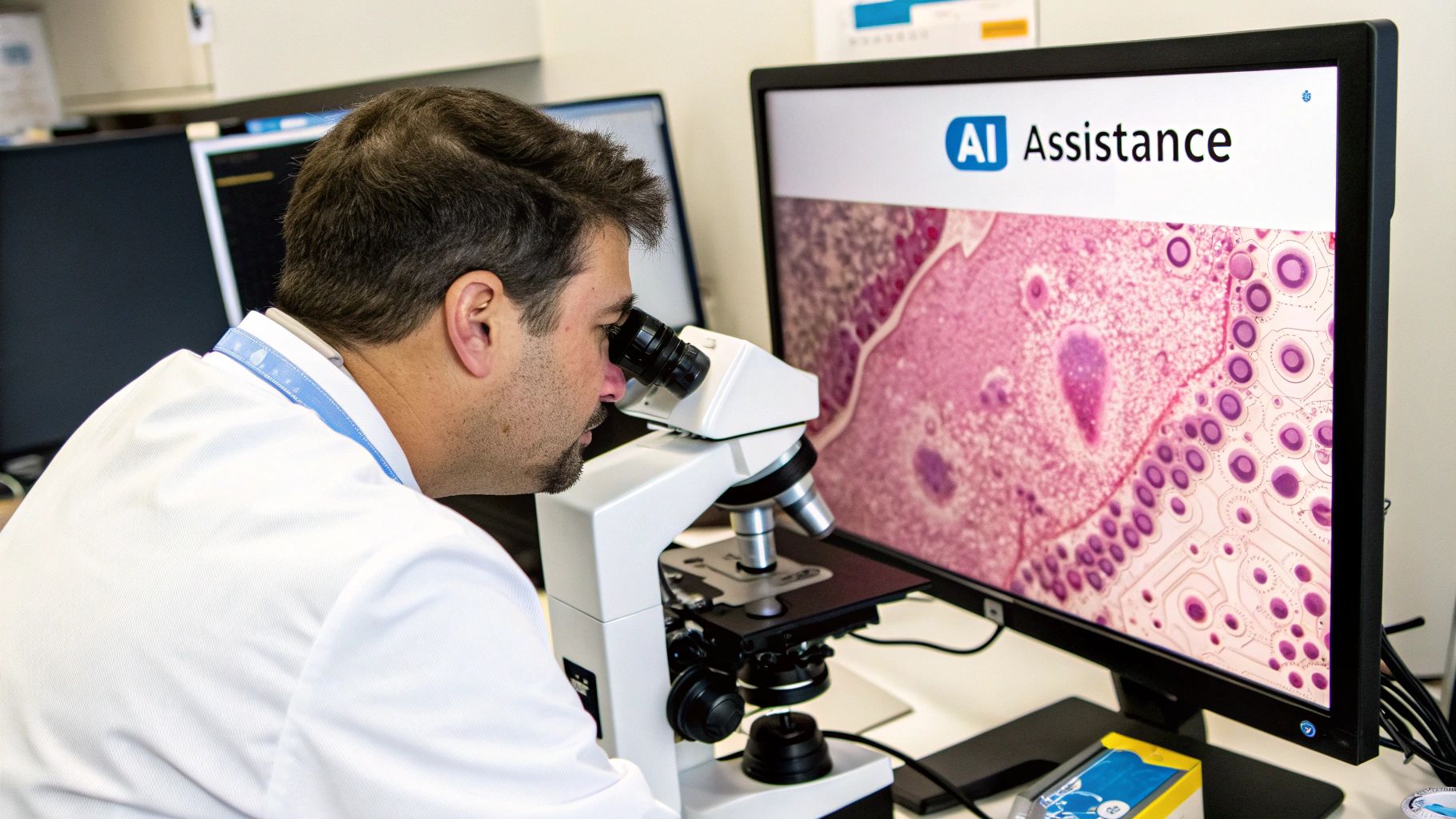
Imagine an AI algorithm as a form of hyper-advanced facial recognition, but for cells. Just as a security system picks a single face out of a massive crowd by recognizing unique patterns, an AI can scan millions of cells across a whole-slide image. It relentlessly hunts for the subtle morphological signatures that hint at disease. It does this with a speed and consistency that's simply beyond human capacity, adding a powerful new dimension to the pathologist's view.
This incredible potential is fueling a massive wave of investment. The global digital pathology market, valued at around USD 9.1 billion in 2025, is set to explode, growing at an estimated 13.1% compound annual growth rate. By 2035, experts predict the market will hit nearly USD 31.3 billion, with AI being one of the main engines driving that growth.
Automating the Tedious to Reveal the Critical
One of the most immediate wins with AI is its knack for handling routine, time-consuming tasks with unblinking accuracy. This is a game-changer for modern digital pathology software, letting experts get more done and focus on what truly matters.
Here’s where AI shines:
- Quantitative Cell Counting: Manually counting things like mitotic figures is not only tedious but can vary from one person to the next. An AI can count thousands of these cells in a flash, delivering objective, hard data for a more evidence-based diagnosis.
- Tumor Grading Assistance: Algorithms can analyze key features like nuclear pleomorphism and mitotic activity to help grade tumors. This provides a consistent, reliable baseline for the pathologist to then review, refine, and confirm.
- Flagging Suspicious Areas: Think of AI as a vigilant screener that does a first pass on every slide. It highlights any regions of interest that might need a closer look, creating a digital safety net to ensure even the tiniest anomalies don't get missed.
The real magic of AI lies in its ability to transform enormous fields of visual information into structured, actionable data. By quantifying what was once purely qualitative, it gives pathologists a whole new layer of objective evidence to back up their diagnostic decisions.
From Diagnosis to Prediction
But AI’s impact goes way beyond just identifying what’s happening in a tissue sample right now. It's rapidly becoming a tool for seeing into the future, helping clinicians forecast disease progression and make smarter treatment calls.
By spotting complex patterns that are often invisible to the human eye, predictive algorithms help answer some of medicine’s toughest questions. For instance, an AI can analyze a tumor's microenvironment to predict how it might respond to a specific immunotherapy, paving the way for truly personalized treatment plans. This elevates pathology from a purely diagnostic field into a prognostic and predictive one.
To get a better handle on the nuts and bolts of how this works, you might find our guide on https://pycad.co/artificial-intelligence-in-pathology/ insightful.
This whole shift is powered by sophisticated algorithms trained on huge datasets of images linked to real-world clinical outcomes. If you’re curious about the specialized work that goes into creating these systems, you can explore what’s involved with AI development services.
At PYCAD, we’re fully committed to this future. That's why we at PYCAD, build custom web DICOM viewers and integrate them into medical imaging web platforms, creating a solid foundation for the AI-powered diagnostics of tomorrow. By engineering platforms that can effortlessly plug into AI workflows, we’re helping labs get ready for the next evolution in pathology.
AI doesn't diminish the pathologist's role—it amplifies it. It forges a powerful human-machine partnership destined to change patient care for the better.
A Practical Guide to Digital Adoption
Making the leap to a fully digital workflow isn't just a technical upgrade; it's a fundamental shift in how your lab operates. Think of it less like flipping a switch and more like embarking on an expedition. It requires a thoughtful blend of technology, people, and strategy, all pulling in the same direction. For any lab ready to step into this future, a clear roadmap is the single most important tool for turning glass slides into dynamic, accessible digital images.
https://www.youtube.com/embed/4oA6xvAryJw
And this isn't just a niche trend—it's a movement with serious momentum. The digital pathology market was valued at an impressive USD 1.30 billion in 2024. Projections show it soaring to an estimated USD 2.75 billion by 2030, growing at a powerful compound annual growth rate of 13.5%. A huge driver behind this is telepathology, which frees pathologists to review cases from anywhere, smashing geographical barriers. Of course, challenges like high initial costs and finding trained staff are still part of the conversation. You can dive deeper into the numbers in this digital pathology market analysis.
Charting Your Course: Hardware and Software
Your journey begins with choosing the right gear. This foundation has to be rock-solid because everything you do from here on out will be built on top of it. Your hardware is the bridge from the physical to the digital world, and your software is what breathes life into those newly created digital assets.
Here’s what to focus on first:
- Whole-Slide Scanners: This is the digital eye of your lab. You need to think carefully about its throughput (how many slides can it handle in a day?), the crispness of the image quality, and whether it can accommodate the different slide types you use.
- Storage Solutions: Let's be clear: digital slides are huge. We're talking gigabytes per case. You absolutely need a robust plan, whether that means on-site servers you manage yourself or a secure cloud platform built to handle the load.
- Software Integration: Your chosen digital pathology software must talk seamlessly with your Laboratory Information System (LIS). If the systems don't communicate, you're just creating new bottlenecks and headaches, which defeats the entire purpose of going digital.
The real goal here is to create a perfectly synchronized ecosystem. Picture a world-class orchestra—every instrument, from the scanner to the software, must play its part in harmony to produce a flawless result.
Navigating the Human Element
Technology is only half the battle. Honestly, the most critical piece of this puzzle is your team. You can have the best equipment in the world, but if your people aren't on board, the project will stall. Guiding your staff through this transition with empathy, patience, and clear communication isn't just a nice-to-have; it's essential.
This goes way beyond a single training day. It’s about cultivating a new culture and mindset. Start by developing new standard operating procedures (SOPs) that are built for a digital-first reality. Invest in comprehensive training that doesn't just teach clicks and buttons but empowers your pathologists and technicians, helping turn their initial apprehension into genuine confidence. A great strategy is to identify champions within your team—enthusiastic early adopters who can mentor their colleagues and smooth over the bumps along the way. Don't forget, navigating the regulatory side of things is also a big part of the human process; our overview of the medical device regulatory pathway can give you some helpful context here.
The Power of a Perfect Fit
No two labs are the same. Each has its own rhythm, its own unique workflow, and its own specific challenges. A generic, one-size-fits-all software solution can feel like a straitjacket, forcing your team to contort their processes to fit the tool's limitations.
This is why a tailored approach is so incredibly powerful. The most successful digital transitions happen when the technology is sculpted to fit the lab's operational DNA.
At PYCAD, this is precisely what we do. We at PYCAD, build custom web DICOM viewers and integrate them into medical imaging web platforms. Our goal is to ensure your software feels less like a tool you have to use and more like a natural extension of your diagnostic process. We operate on a simple principle: the software should work for you, not the other way around. To get a better sense of how we bring this philosophy to life, take a look at our work on our portfolio page.
Where We're Headed: A Global, Collaborative Future in Diagnostics
So, where does digital pathology go from here? We’ve spent years bringing the laboratory into the digital world, but the next great leap is about connecting those labs. We're on the verge of creating a truly global diagnostic network. The future isn't just about digital slides; it's about a decentralized, deeply collaborative, and incredibly intelligent ecosystem. It’s a future where expertise isn't trapped within hospital walls or by geographic borders.
Cloud-based platforms are the engine driving this change. Picture this: a pathologist in a small, rural clinic is stumped by a rare and complex case. With a secure cloud portal, they can instantly share the digital slide with a renowned sub-specialist thousands of miles away. That expert can then view, pan, zoom, and annotate the image in real-time, offering their insights as if they were sitting right there in the room. This isn't just about convenience—it's a fundamental shift that makes world-class expertise available to anyone, anywhere.
The Rise of Telepathology and Truly Integrated Health
This kind of remote collaboration, or telepathology, is already making a huge difference in patient care, especially for communities that have been historically underserved. It closes critical gaps in healthcare, making sure a patient's diagnosis isn't determined by their zip code. The market reflects this momentum. While North America currently leads the global digital pathology market—valued at USD 490 million in 2024 thanks to AI-powered screening and faster turnarounds—the real story is the growth elsewhere. The Asia-Pacific market is expanding the fastest as new healthcare investments fuel the adoption of these powerful diagnostic tools. You can dive deeper into the numbers in this in-depth market research.
But this interconnectedness goes far beyond just linking two pathologists. The next frontier is weaving pathology data into the complete fabric of a patient's health information.
The diagnostic report of tomorrow won't just be an image with a few notes. It will be a holistic patient portrait, combining pathology insights with genomics, proteomics, and other 'omics' data to create a profoundly personalized view of an individual's health.
This multi-layered approach will empower clinicians to do more than just name a disease. It will help them predict its behavior and choose the most effective, highly targeted therapies. The digital slide becomes a single, vital piece in a much larger, more intricate patient puzzle.
A Connected and Personal Future
Building this future requires a foundation that is robust, flexible, and completely secure. At PYCAD, we see this connected ecosystem as the ultimate destination. That's precisely why we at PYCAD, build custom web DICOM viewers and integrate them into medical imaging web platforms. Our entire focus is on creating the seamless, interoperable systems that will power this new era of collaborative medicine. By making sure data can flow freely and securely between different systems, we're helping to lay the groundwork for a globally connected healthcare system.
The vision is clear: a world where digital pathology software is the key that unlocks advanced, personalized diagnostics for every single patient, no matter where they live. To see how we're contributing to this future, take a look at our work on our portfolio page.
Common Questions We Hear About Digital Pathology
When labs and hospitals first start looking into the world of digital pathology software, a lot of great questions come up. It's a big shift from the way things have been done for decades, so it's natural to want to understand how it all works, what the real benefits are, and how patient data is kept safe.
What’s the Single Biggest Win We’ll See?
Hands down, the biggest win is how it turbocharges your workflow and opens up collaboration like never before. Think about it: digital slides can be shared instantly with a colleague across the hall or a specialist on another continent.
This completely removes the delays, costs, and risks of shipping glass slides back and forth. It means getting a second opinion is faster, global consultations are a reality, and your team can work together on tough cases without missing a beat.
How Does the Software Not Bog Down With Those Giant Image Files?
It’s true, digital pathology images are huge—we’re talking gigabytes. The software handles this with some seriously clever engineering. It uses methods like "tiling" and "pyramiding," which is a fancy way of saying it only loads the exact part of the image you’re looking at, at the zoom level you've chosen.
A great analogy is Google Maps. You can explore the entire planet without downloading the whole world to your computer. The software just serves up the little piece you need, making the experience incredibly fast and smooth.
Is This Software Truly Secure for Patient Data?
Absolutely. Security isn't just a feature; it's the foundation these platforms are built on. Modern systems are designed from the ground up to meet strict healthcare rules like HIPAA.
They use multiple layers of protection to keep patient information locked down:
- End-to-end data encryption
- Strict access controls based on who you are and what you need to see
- Detailed audit trails that log every single action taken
This ensures that sensitive patient data is protected every step of the way.
At PYCAD, we live and breathe these technical challenges. We at PYCAD, build custom web DICOM viewers and integrate them into medical imaging web platforms, making sure your system is not only fast and powerful but also secure and designed for your specific workflow. You can see how we've helped others on our portfolio page.
